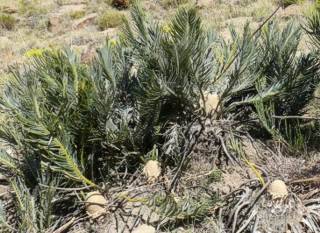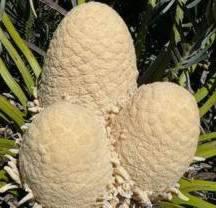Encephalartos cycadifolius
Encephalartos cycadifolius (Jacq.) Lehm.
Family: Zamiaceae
Common names: Bedford cycad
SA Tree No: 14.14
Introduction
Encephalartos cycadifolius is a medium-sized, single to multi-stemmed cycad that is both frost-tolerant and drought-resistant. It is an Eastern Cape species often confused with other grassland cycads such as E. friderici-guilielmi and E. ghellinckii. While it is easy to germinate the seed, the seedlings are slow-growing and require specialized attention in cultivation.

Description
Description
Encephalartos cycadifolius is a slow-growing, single to multi-stemmed cycad, with a stem of 1.0-1.5 x up to 0.25 m. The leaves are dark olive, 0.6-1.0 m. The yellow-orange leaf stalk has a slight spiral twist. The leaflets have no thorns and are attached in a V-shaped formation. Male and female plants usually bear one or two yellow cones covered with grey hair, becoming brown with age. Male cones are 150-200 x 50-80 mm. Female cones are 200-300 x 160-180 mm.

Conservation Status
Status
According to the IUCN specialized cycad group, Encephalartos cycadifolius is Vulnerable.
Distribution and habitat
Distribution description
Encephalartos cycadifolius has a restricted distribution in the Winterberg Mountains in the Bedford and Cradock areas. It occurs on mountainsides among rocks in full sun on the northern and eastern slopes at altitudes of up to 1800 m.


Derivation of name and historical aspects
History
Encephalartos is derived from the Greek word meaning within-head bread, referring to traditional use of the bread-like starchy substance from the plant stem pith. The specific name cycadifolius is from the Latin word meaning cycad-like leaves.
Ecology
Ecology
Encephalartos cycadifolius is frost- and drought-tolerant and well-adapted to fire, which stimulates formation of cones and leaves. Porcupines and baboons break off both male and female cones for food.
Uses
Use
Thus far there are no known specific recorded traditional or cultural uses for E. cycadifolius.
Growing Encephalartos cycadifolius
Grow
Encephalartos cycadifolius is easily grown from seed. In cultivation, pollination is necessary for a successful seed harvest. Pollen can be collected as soon as the male cones begin shedding (if a light tapping of the male cone produces pollen then the cones are ready to harvest). The collected pollen must be stored at minus 15º C for best results. The female cone has to be monitored to check when the scales open. The window of the scale opening varies from plant to plant, and may last from three days to two weeks. We have achieved a good pollination rate at Kirstenbosch using the wet method (pollen mixed with distilled water and applied by syringe).
After female cones have been collected, the seed is left to mature for a year before sowing at the beginning of summer. For best results, seed is sown in river sand on a heated bench at 24-28º C. Germination should start three weeks after sowing, but may sometimes take longer.
Special care must be taken when adult plants are transplanted, as Encephalartos cycadifolius is slow-growing and can easily die or take a long time to recover from relocation. Leaves and cones are prone to scale and mealy bug. Each spring at Kirstenbosch, we feed each plant with a nitrogen (N), phosphorus (P) and potassium (K) mixture of 3:1:5, as well as bone meal and an organic fertilizer (Bounce back®). We also add a generous helping of compost at regular intervals during the year.
References
- Donaldson, J.S. (ed.). 2003. Cycads. Status Survey and Conservation Action Plan. UCN/SSC Cycad Specialist Group, IUCN, Gland, Switzerland and Cambrige, UK.
- Dyer, R.A. & Verdoorn, I.C. 1966. Zamiaceae. Flora of southern Africa 1: 8-10. Botanical Research Institute, Pretoria.
- Giddy, C. 1974. Cycads of South Africa. Struik, Cape Town.
- Website: http://www.cycadsociety.org/cycadifolius/cycadifolius.html
Credits
Phakamani M' Afrika Xaba
Kirstenbosch National Botanical Garden
April 2009
Plant Attributes:
Plant Type: Shrub, Tree
SA Distribution: Eastern Cape
Soil type:
Flowering season:
PH:
Flower colour:
Aspect:
Gardening skill: Challenging
Special Features:
Horticultural zones









Rate this article
Article well written and informative
Rate this plant
Is this an interesting plant?
Login to add your Comment
Back to topNot registered yet? Click here to register.